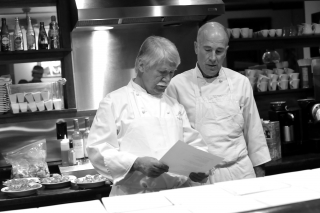
It Takes an Industry Community to Educate Today’s Culinary Student
09 August 2016Chef educators are tasked with demands to stay relevant while teaching soon-to-be graduates “kitchen-ready” skills all the while meeting institutional standards. A difficult task that can be accomplished with assistance. Educators, you are not alone!
By Paul Sorgule, MS, AAC
The demands placed on culinary educators have never been greater. Gone are the days when a teacher’s only responsibility was to deliver information to students and test their ability to retain what was offered. Today’s culinary educator and culinary administrator must approach his or her position with an understanding of and ability to:
- Inspire
The teacher must be the role model, the example of professionalism and excellence that inspires a student to emulate these actions. It is the chef instructor’s experience, standards of excellence, professionalism, fairness, and unfaltering dedication to doing things right that creates a level of excitement and personal commitment in the classroom and the kitchen.
- Acclimate
The chef instructor and administrator must be prepared to effectively acclimate students to college, to the program, and to the demands of the professional kitchen beginning with those initial lab courses.
- Skill Development
The foundational technical skills associated with cooking are the backbone of a successful career. The chef instructor must have the ability and the patience to ensure every student who passes through a culinary program is prepared to be “kitchen ready.” These skills are the price of admission for all who are accepted into a program and who choose to make a career out of cooking.
- Relevance
It is the administrator’s responsibility to facilitate the development of a relevant program where each course is designed to play a role in preparing students for the food industry‘s demands. These courses need constant assessment to ensure they meet the expectations of those who will eventually hire graduates. It is the chef instructor’s responsibility to execute this curriculum and effectively evaluate student performance to an industry-accepted standard.
- Stay Current
Staying abreast of new products, concepts, methods, and standards of excellence as defined by the food industry, professional organizations, and peers is an ongoing process that demands the attention of administrators and teachers.
- The Foundations vs. Special Interests
Separating what is critical from what is a niche trend is important. However, administrators and instructors cannot ignore those trends that often drive progress in the restaurant industry and excite students enrolled in a curriculum. Staying current and knowing how to separate the necessary from the nice is a never-ending responsibility.
- Plan for the Whole and Teach to the Individual
Programs, administrators and faculty must be prepaed to uphold standards across the curriculum for all who are enrolled, but at the same time they must be adept at identifying students who struggle and design alternative methods for the delivery of material and building retention initiatives that support these students.
- Teach Behavior as well as Technique
How people interact with others in food establishments is of key concern when helping to build a student’s professional persona. It is the responsibility of the director and faculty member to set the stage for teamwork, shared responsibility, openness and tolerance.
- Create Realistic Expectations
Knowing what future employers are looking for and matching student expectations to this will help set the stage for a successful career path. It is essential that a graduate’s skill set grows as he or she builds a career and that graduate must have patience to know time in the trenches is necessary.
- Gainful Employment
It is the responsibility of the program, the director, and every faculty member to demonstrate and create value, and to build those connections that will help students find employers who will help them move steadily toward their career goals.
- Light a Fire – Build the Passion
Keeping students engaged, presenting a dynamic curriculum with energy and promise, and pushing the right buttons in an effort to move students toward reaching their potential – these are critical responsibilities of everyone involved in culinary education.
This is a sample of the challenges faced by those in culinary education. How is all of this possible within the parameters of a curriculum that also must meet institutional standards as well as those of your respective Stated Education Department?
You are not alone! There is ample help from a multitude of sources. CAFÉ is your portal that connects faculty and department chairs with industry leaders. Class materials, established product curriculum, resource guides, current trend blogs, downloadable handouts, and much more is available for the asking.
CAFÉ is your link to a community that can help you and your faculty members become the best that they can be. Interact with the resources on the CAFÉ website, attend the Deans and Directors Retreat, and send your faculty to the annual Leadership Conference. These are investments in building and growing your program and providing a dynamic, current, high-energy curriculum for every student enrolled in your program.
Paul Sorgule, MS, AAC, president of Harvest America Ventures, a mobile restaurant incubator based in Saranac Lake, N.Y., is the former vice president of New England Culinary Institute and a former dean at Paul Smith’s College. Contact him at This email address is being protected from spambots. You need JavaScript enabled to view it..
